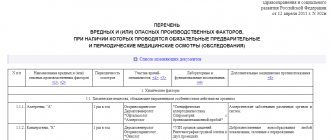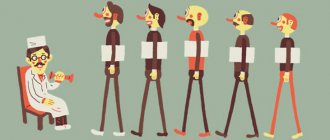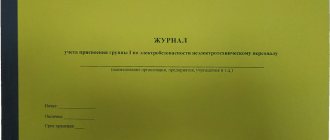Which workers require medical examinations?
Employees subject to periodic medical examination:
- traffic related employees;
- involved in hazardous or heavy production;
- attracted to work in the Far North;
- emergency services and security personnel;
- food industry workers;
- underground and high-altitude workers;
- athletes;
- educational staff;
- persons under 18 years of age;
- working on a rotational basis, etc.
Any deviations in the well-being of these employees can negatively affect not only their productivity, but also their own health and the health of others.
If the medical examination is not passed
When a medical examination is not passed, this can lead to negative consequences:
- The employee should not be allowed to perform tasks.
- If the employee has been allowed to work, then responsibility is transferred to the manager of the facility.
- If a violation is detected due to failure to pass a medical examination, the labor inspector will impose a fine.
- If an employee is diagnosed with an occupational disease and is still involved in work, then management will be responsible.
- Under any circumstances, failure to undergo medical examination is a violation of regulations, and this entails liability.
Preventive examinations
Preventive medical examinations are carried out for various categories of citizens in order to identify possible deviations in health status and to prevent the development of diseases. In addition, thanks to this examination, the health group to which they belong is established for citizens.
Preventive medical examinations include the following examination methods:
- questionnaire - a general survey about the state of health, the presence of bad habits, etc.;
- anthropometry - measurement of height, weight and other anthropometric indicators;
- pressure measurement;
- sampling;
- fluorography of the lungs;
- electrocardiogram;
- examination by a general practitioner.
Health groups:
- Group I: absolutely healthy people;
- Group II: people with minor health problems;
- Group III: people with serious, including chronic diseases.
Unscheduled, extraordinary
To maintain safety when performing work, the legislation provides for unscheduled and extraordinary inspections. The medical examination includes a set of measures aimed at identifying pathological abnormalities. Unscheduled medical examinations exist, and an employee can undergo them in advance, regardless of the schedule.
The right to referral is also granted to the employer.
A medical examination may be carried out unscheduled.
This happens in cases where:
- the employee’s health has deteriorated and he is unable to work;
- if there is a suspicion of an occupational disease;
- there is a need to confirm your health status;
- when extraordinary medical examinations are carried out;
- for those working in the field of trade and food;
- health workers;
- employees of child care institutions;
- drivers.
If there are no recommendations from management to undergo the examination, then the employer has the right to send the employee to undergo it himself.
Based on the completed examination, the enterprise administration decides whether to allow the employee to perform production tasks.
If health does not allow working under these conditions, then the company management may remove the employee from work.
Preliminary examinations
This medical examination is usually carried out when a new employee is hired. It is necessary to determine possible deviations in the employee’s health status. Some deviations may make it impossible to hire him, so the employer is obliged to insist on undergoing an examination. This is a prerequisite for concluding an employment contract in some areas of activity.
The categories of employees for whom a medical examination upon hiring is mandatory have been identified above.
Types of medical examinations for workers
In accordance with the norms of labor legislation, namely stat. 212 of the Labor Code of the Russian Federation, the employer is obliged to ensure compliance with safe working conditions and create a labor protection system at the enterprise. In particular, this also applies to organizing medical examinations for various purposes at our own expense. At the same time, it is prohibited to allow employees to perform their work duties without undergoing medical examinations or psychiatric examinations, as well as in the presence of appropriate contraindications.
Such therapeutic and preventive measures (TPM) are carried out in order to preserve the health and life of personnel in accordance with labor protection standards. The order, frequency and document flow of actions depend on the purpose and purpose of the CVL. So, currently there are the following types of inspections.
Types of medical examinations according to Federal Law No. 323 of November 21, 2011:
- Preliminary tests are carried out at the stage of a specialist’s entry into official work in order to establish the actual state of a person’s health. Such measures are mandatory if workers of certain specialties are employed, for example, military personnel or persons applying for work in dangerous/harmful working conditions. Among the list of documents received from the personnel officer is a medical report. And to undergo this type of inspection, you will need a referral from the employer indicating the hazard class. If an individual refuses to undergo inspection, the employer does not have the right to hire him for a position, since labor safety requirements are not met in this case. In addition, preliminary examinations are required when applying for training in accordance with Part 7 of Art. 55 Federal Law No. 273 dated December 29, 2012
- Periodic – carried out while employees are performing their job duties, that is, directly during employment with the employer. The main goal of such PMPs is to establish the compliance of the specialist’s health status with the position held and the functions performed. It is with the help of periodic examinations that it is possible to promptly detect the onset of a disease, detect early signs of the harmful effects of working conditions, form risk groups, and detect those diseases that are medical contraindications and are reasons for removal from a position. In addition, based on the conclusions of periodic examinations, doctors prescribe rehabilitation treatment measures aimed at restoring the employee’s ability to work and maintaining his health. The frequency of examination is regulated at the legislative level and depends on the nature of employment and the position held. Thus, individual categories are listed in the stat. 213 TK. These are, for example, workers in the transport sector and food industry, employees of catering and child care institutions, etc.
- Extraordinary or unscheduled - such inspections are performed outside the generally established frequency. Mainly, the reason for such events may be the personal requests of employees or the decision of the employer based on available medical information. conclusions to establish the presence of the disease. A one-time extraordinary examination is mandatory as prescribed by the territorial bodies of Rospotrebnadzor of the Russian Federation in the event of an unfavorable epidemiological or sanitary situation. For example, during poisonings in schools.
- Pre-shift/post-shift, pre-trip/post-trip – certain categories of work require more frequent inspections than in general cases. Thus, drivers are required to undergo a daily examination before being allowed to drive a vehicle to identify the presence of diseases and determine their state of health. Such pre-shift or pre-trip inspections are permanent in nature and give grounds for responsible persons to make a conclusion about admission to the current shift. This includes assessing the possibility of toxic, alcohol or drug intoxication. After a shift/flight, at the end of the working day, a similar inspection is performed with mandatory recording of the influence of harmful production factors of working conditions on a person’s health.
Note! Some specialists may have their own frequency of inspections depending on working conditions - the list of dangerous/harmful factors is regulated in Order No. 302n.
Periodic examinations
The next type of medical examination is called periodic. As the name implies, employees are required to undergo this type of examination at intervals established by labor legislation. The frequency depends on the specific profession and working conditions. The minimum period between inspections is no more than two years.
The frequency of medical examinations for some professional sectors is indicated in the table.
| 1 time per year | Employees of grocery stores, catering, food production, pharmacy employees |
| Service workers (hotels, sports centers, laundries, beauty salons) | |
| Employees of explosion and fire production, emergency services, underground and high-rise works | |
| Workers of kindergartens, schools, boarding schools, children's camps and sanatoriums | |
| 1 time every 2 years | Underwater work, control of land transport, work on machines, with electrical equipment |
Mandatory periodic medical examinations show the dynamics of the employee’s health status, identify the presence of diseases incompatible with the profession, and carry out the necessary measures to maintain health and rehabilitation.
Why send workers for a medical examination?
The term “medical examination” in the professional sphere has replaced the concept of “medical examination”. In fact, both of these denote a set of measures to study the employee’s health, identify possible pathologies and prevent them. It is the physical condition of the employee that will determine how suitable he is for performing certain job duties. To understand whether a subordinate’s health corresponds to his position and paid activities, the employer sends his company’s employees for a mandatory medical examination.
First of all, periodic medical examination is necessary for workers in professions associated with danger: firefighters, rescuers, miners. The category of hazardous industries also includes enterprises whose activities involve chemical mixtures, biological matter, allergens, toxins, and ultraviolet radiation.
The health status of employees of such companies must be monitored in order to avoid a sharp deterioration and prevent loss of ability to work or possible work-related injuries. If production employees are affected by at least one of the factors, a medical examination should be organized once a year or more often.
Workers in the food sector, trade or public catering organizations, teachers in school and preschool institutions undergo a medical examination in order to preserve their own health and the safety of those with whom the employee comes into contact. In addition, the goals of medical examinations include monitoring the health dynamics of employees and preventing the development of diseases associated with professional activities.
Control of this aspect of labor is legally assigned to the head of the company. It is he who is required to determine how often employees must undergo mandatory medical examinations, whether a medical examination is necessary for the candidate before taking office, and other organizational issues.
Pre-shift and pre-trip inspections
In a number of professions, especially those associated with emotional or psychological costs, as well as those requiring a lot of concentration, a medical examination for an employee must be carried out before each departure to work.
Pre-shift and pre-trip medical examinations are carried out especially carefully for machinists, drivers, and pilots. Poor health of these employees or other reasons for their unwillingness to fully perform their duties may threaten the health of other people. Pre-shift and pre-trip medical examination may include, among other things, testing for the use of alcohol, narcotic and psychotropic substances.
This type of medical examination is carried out at the end of a shift or flight and reveals the fact of exposure to harmful production factors on the employee, the presence of an acute occupational disease, and so on.
Electrocardiography
Amplification and recording of electrical impulses of the heart. After registration, data on the characteristics of these pulses are transferred to paper in the form of a group of broken curves. Each of them characterizes the activity of a particular department or structure of the heart. Used to detect heart rhythm disturbances, problems with blood supply to the heart, complications after a heart attack, etc. The study is painless; during it, several sensors are attached to the patient’s chest, arms, and legs. The procedure takes a few minutes. It is possible to conduct a daily ECG (extended examination during the day), take an ECG under load or after taking certain medications.
Extraordinary inspections
An extraordinary inspection is unscheduled and may take place earlier than scheduled. It is carried out at the request of the employee if he suspects the development of an occupational disease. It can also be performed in the event of a serious infectious disease.
These are the main types of medical examinations. Each inspection must be carried out carefully and in accordance with the objectives, since neglecting these inspections can lead to sad or tragic consequences.
For whom is a medical examination mandatory?
The legislation establishes a list of specialists for whom all types of preventive examinations are mandatory. These categories include:
- citizens working in kindergartens and schools;
- employees whose activities are not without the influence of harmful production factors;
- medical specialists;
- drivers.
A medical examination for the above citizens allows timely detection of the first signs of occupational diseases.
Payment for medical examinations
Regardless of the type of examination, the costs of conducting it are borne entirely by the employer. On days when an employee is absent from work due to undergoing a medical examination, his average salary is retained. If the employee paid for the examination himself, then he can write an application for compensation of all costs.
Some clinics provide discounts to companies for conducting examinations. The employee's medical record is kept by the employer.
The essence of the 302nd order
Order 302 on medical examinations adopted by the Ministry of Health and Social Development dated April 12, 2011 establishes mandatory preliminary and periodic medical examinations for workers involved in hazardous types of production and in contact with factors harmful to health.
All of the above types, according to Articles 212 and 213 of the Labor Code, must be carried out at the expense of the employer. And during their passage, the employee retains his average salary and position. This is stated in articles 185, 212 and 219 of the Labor Code of the Russian Federation. The costs of such medical examinations are taken into account in the expenses of profit, in accordance with subparagraph. 7 clause 1 art. 264 Tax Code of the Russian Federation. The Ministry of Finance recalled this in a letter dated November 26, 2018 No. 03-03-06/1/85069.
Let's consider order 302 on medical examinations with amendments for 2021 with appendices numbered 1, 2 and 3.
Appendix 1 contains a list of harmful and/or dangerous production factors, in the presence of which mandatory preliminary and periodic medical examinations (examinations) are carried out. This list has become one of the main innovations in the field of employee health monitoring. The information in this regulatory act is presented in the form of a table, which, in addition to the names of harmful phenomena at work, indicates the frequency of examinations and a list of doctors whom employees must visit. For example, those who have contact with nitrogen compounds should visit an otolaryngologist and dermatovenerologist once every two years.
The list of jobs for which it is mandatory to undergo medical examinations contains Appendix 2 (changes in Order 302n in 2021 are also included there). The table provides a list of types of activities, frequency of visits to doctors, their list, types of necessary tests and contraindications for continuing to work. For example, Appendix 2 (clause 2) of Order 302n states that workers involved in the maintenance and repair of electrical installations must be examined by an ophthalmologist, ENT specialist and neurologist once every 2 years. And if, for example, cerebral ischemia, hernias or disruption of the vestibular apparatus are detected, this will become a contraindication to continued work.
Appendix 3 provides the procedure for undergoing medical examinations for workers employed in hazardous and hazardous industries and performing hard work.
We especially note that employees under the age of 18 are subject to mandatory medical examination, and employees under the age of 21 are required to undergo a medical examination annually.
Procedure for medical examinations
The algorithm for undergoing a medical examination is usually clearly established by law and organization. The procedure for the employer, employee and medical organization is given below.
Actions on the part of the employer:
- compiling a list of employees subject to mandatory examination;
- sending the list to Rospotrebnadzor;
- establishing dates for examination with the clinic;
- providing a list of employees required to be examined to the medical organization (at least two months before the agreed date);
- familiarizing employees with the medical examination schedule;
- registration and issuance of referrals for medical examination to employees;
- providing the results of the medical examination to the Social Insurance Fund of the Russian Federation.
Actions on the part of the medical organization:
- drawing up a medical examination schedule and coordinating it with the employer and clinic management;
- formation of a medical commission;
- registration of patient medical records;
- conducting a medical examination;
- filling out a report on the examination results and issuing a health passport;
- issuing referrals for additional professional examinations (for some professions);
- provision of final data to the employer.
Actions on the part of the employee:
- familiarize yourself with the medical examination schedule;
- prepare for the examination, collect the necessary tests;
- come to a medical organization and undergo a medical examination and, if necessary, additional examinations.
Magnetic resonance imaging
This diagnostic method uses a magnetic field to obtain high-resolution images of internal organs or tissues. For the examination, a device with a camera is used, inside which the patient is located. This device provokes an electromagnetic response from atomic nuclei. The response is recorded and translated into a two-dimensional or three-dimensional image.
MRI allows you to obtain layer-by-layer images of organs and tissues. Used in the diagnosis of diseases of the spinal cord, brain, and internal organs. Gives high accuracy. The procedure takes about half an hour, it is painless, but is not suitable for people with a fear of closed spaces. Not used for diagnosing heart disease.
What kind of doctors do employees undergo?
The standard list required to pass includes the following specialists:
- therapist;
- neurologist;
- ophthalmologist;
- otolaryngologist;
- endocrinologist;
- gynecologist (women only).
In addition, an examination by a narcologist, psychiatrist, venereologist, surgeon, dentist, dermatologist, etc. may be scheduled.
In addition to examination by specialists, employees must undergo the following examinations:
- electrocardiogram;
- fluorography;
- general blood and urine analysis;
- smears for flora and cytology (only for women).
Additional studies include a biochemical blood test, analysis for intestinal infections, and ultrasound.
Endoscopy
The study is performed using an endoscope - an instrument with a flexible fiber-optic tube with a diameter of 8 to 15 cm. It allows you to “see” organs from the inside, obtain an image of the bronchial mucosa, stomach, etc.
Some equipment allows you to take tissue samples during the study. Endoscopes are used in gastroenterology, pulmonology, urology and gynecology, cardiology, etc. You have questions?
We will call you back within 30 seconds
or call the number
Clicking the "Submit"
, you automatically consent to the processing of your personal data and accept the terms of the User Agreement.
- Preventative medical examination for the elderly
- Types of instrumental examinations
- Laboratory diagnostics: main types of tests
Stages of conducting a medical examination at an enterprise
Issues related to the organization of preventive medical examinations are dealt with by the management of the organization. The procedure is carried out in several stages, the organization of which is based on certain medical regulations.
Stage No. 1. Preparation
At the initial stage, a list of all professions in the organization is compiled, which indicates harmful, potentially dangerous factors and work that can negatively affect the health of employees. The lists are determined on the basis of a qualified assessment of working conditions, and only those professions that are included in the category of harmful or dangerous are included in the list. The list must indicate the name of the profession, harmful production factor, and list of works. The completed document, which will become the basis for organizing a preventive medical examination, should be sent to the territorial Office of Rospotrebnadzor within ten days.
Based on the list of professions associated with harmful and dangerous factors, a list of workers by name is compiled who require preliminary or periodic professional examination. The document contains the following information:
- Full Name.
- Profession (position).
- Name of the structural unit.
- The name of the negative production factor or type of work.
At the end of the preparatory period, the head of the enterprise is obliged to familiarize his subordinates with the calendar plan for undergoing a preventive examination, and also give them a referral letter against signature.
Stage No. 2. Conducting a preventive medical examination
Employees who are required to undergo a professional medical examination must report to the clinic according to the schedule established by the enterprise. You must have with you:
- passport;
- direction.
If for any reason an employee does not appear for a medical examination, the employer has every right to remove him from work without saving his salary. If the professional examination is missed due to the fault of the employer or for reasons beyond the control of the employee, the refusal to perform duties is classified as simple and paid in the amount of 2/3 of the salary.
The list of mandatory laboratory and instrumental diagnostic tests depends on the harmfulness and danger of production factors prevailing at the enterprise. But regardless of what specific activity is characteristic of a particular organization, all employees being examined must undergo the following laboratory tests:
- general clinical analysis of blood, urine;
- biochemical screening;
- blood test for sugar levels;
- bacteriological, cytological examination in women.
It is also mandatory to undergo the following types of instrumental diagnostics:
- Fluorography of the chest. Helps in the initial stages to identify such dangerous diseases as tuberculosis, lung cancer, cysts, sclerotic changes, fibrosis, and detect foreign bodies. X-ray examination without risk to health can be done no more than once a year. If there are no suspicious signs in the image, the doctor issues an appropriate conclusion.
- Electrocardiography. A diagnostic procedure that allows you to assess the general physical condition of the heart muscle, its electrical properties, the presence of rhythm and conduction disturbances, identify acute ischemia, and determine ventricular and atrial dysfunction. The procedure does not require special preparation, but before it is carried out it is not advisable to drink coffee, black tea and other energy drinks, as well as alcohol.
- Mammography. The procedure is prescribed for women. It is an x-ray examination, the result of which is an image that allows the doctor to detect any pathological changes in the mammary glands in the initial stages of development. Mammography reveals malignant and benign tumors, including: mastopathy, calcifications, fibroadenomas, cystic neoplasms.
As part of a preventive medical examination, employees of the organization must visit the following highly specialized specialists:
- therapist;
- otolaryngologist;
- surgeon;
- ophthalmologist;
- neurologist;
- gynecologist or urologist-andrologist;
- endocrinologist;
- psychiatrist;
- expert in narcology.
Stage No. 3. Summing up and drawing up the final act
The medical commission, based on the results of the examination, draws up a medical record for each employee in form No. 025/u, a health passport, and a conclusion based on the data of a preliminary or periodic medical examination. Within thirty working days, the commission summarizes all the results, after which it draws up a final act, which is then sent to the territorial department of Rospotrebnadzor. Once the final act has been agreed upon with this organization, the preventive medical examination can be considered completed.
conclusions
There are several types of medical examinations to which the employer must send some working citizens. There are categories of workers who must undergo mandatory examinations.
The characteristics of his or her activities play a key role in determining what kind of medical examination an employee will undergo. For example, drivers are required to undergo examination before and after the trip. Employees working in an office are examined every few years (medical examinations of office workers).
What documents are required to undergo a medical examination?
To undergo any type of medical examination, you must have the following documents with you:
- Passport or ID
- Direction for passage from the organization
- Outpatient card
- Extract with the results of previous examinations
- Conclusion of a psychiatric commission (on request).
Responsibility is provided for the lack of a professional examination among employees of enterprises and organizations.
The Rospotrebnadzor inspection regularly checks all enterprises for violations of labor laws. An organization can be fined up to 50 thousand rubles and even have its activities suspended for up to 90 days if employees do not undergo a mandatory periodic medical examination. The head of the company himself will also be subject to a fine of 1 to 5 thousand rubles and may be suspended from office for a period of 1 to 3 years.
Types of medical examinations
Preliminary
A preliminary medical examination of employees helps to find out whether the general health of the future employee allows him to fully perform his duties in a certain position. Also, with the help of this type of preventive examination, it will be possible to identify hidden diseases at the initial stage of development, begin treatment on time and prevent the development of complications.
The following are required to undergo a preliminary medical examination:
- Persons whose professional activities involve managing complex machines and mechanisms.
- People working in high-risk conditions.
- Workers driving vehicles.
- Food industry employees.
- Medical workers and persons working in children's educational institutions.
Periodic
Periodic medical examinations of employees are carried out for the purpose of:
- Observe and control the health status of workers who perform duties in conditions of increased harm and danger. Such persons are especially susceptible to developing occupational diseases, but with the help of a professional examination it will be possible to diagnose the disorder in time and begin its treatment.
- Detect diseases in the development of which work in conditions of increased danger and harmfulness is contraindicated.
- Carry out timely preventive and remedial measures that will help prevent the development of occupational diseases among workers.
- Timely identify and begin treatment of infectious diseases that are contagious and dangerous to others.
- Prevent and prevent accidents and incidents in the workplace.
Periodic medical examinations by doctors deserve special attention. Medical workers have direct contact with patients and can be carriers of various infectious diseases that pose a threat to the health and lives of others. Therefore, it is important to take the organization of the inspection procedure seriously and responsibly. If a medical worker refuses to undergo a medical examination or for some reason has not passed it, the management of the medical institution does not have the right to allow him to work.
Expertise of professional suitability
The examination of professional suitability is carried out in accordance with Order of the Ministry of Health of Russia dated May 5, 2021 N 282n and is carried out based on the results of preliminary and periodic medical examinations of workers. The medical commission, based on the results of preventive examinations, makes one of the following decisions on the employee’s health status:
- Fully suitable for certain types of work.
- Due to health reasons, temporarily unfit to perform duties.
- Due to health reasons, he is permanently unfit to perform certain types of work.
- The conclusion of the medical commission is drawn up in two copies:
- One is given to the employee to present to the employer. The employee must sign in the journal for registering medical reports regarding receipt of the document.
- The second is attached to the employee’s medical card and is stored in the clinic for 50 years.










